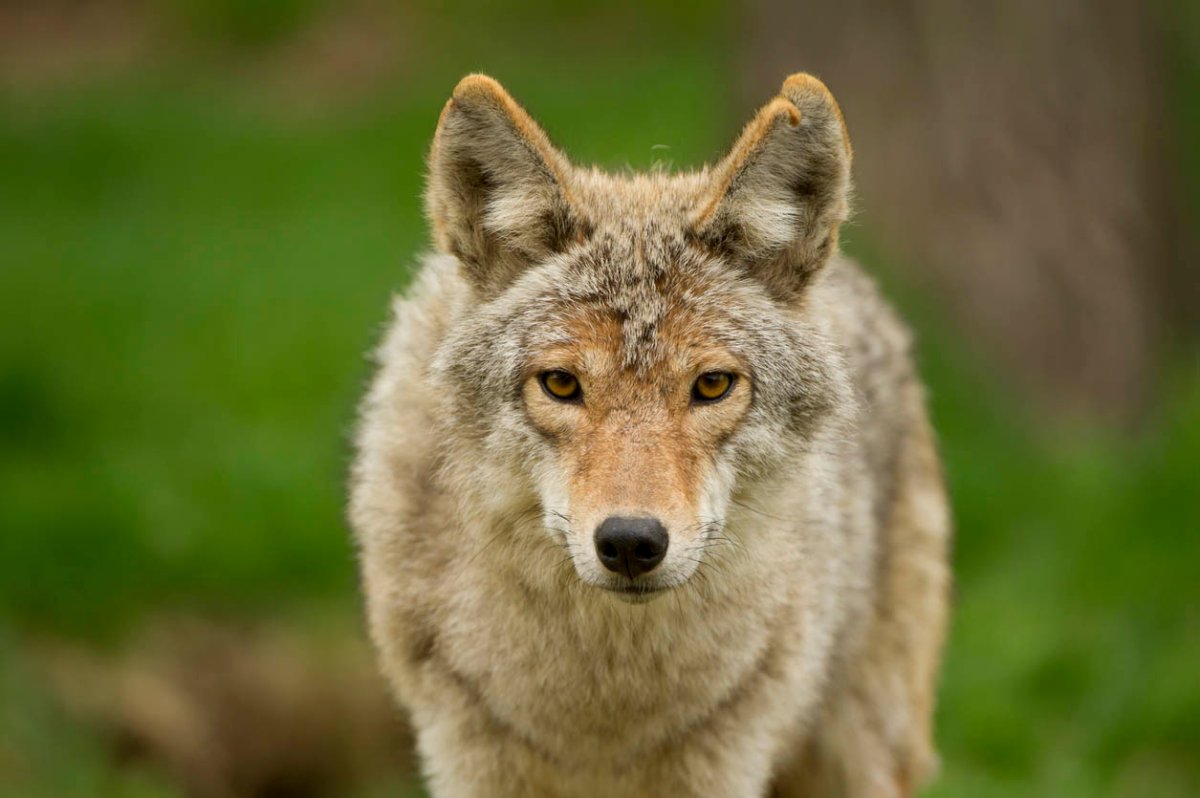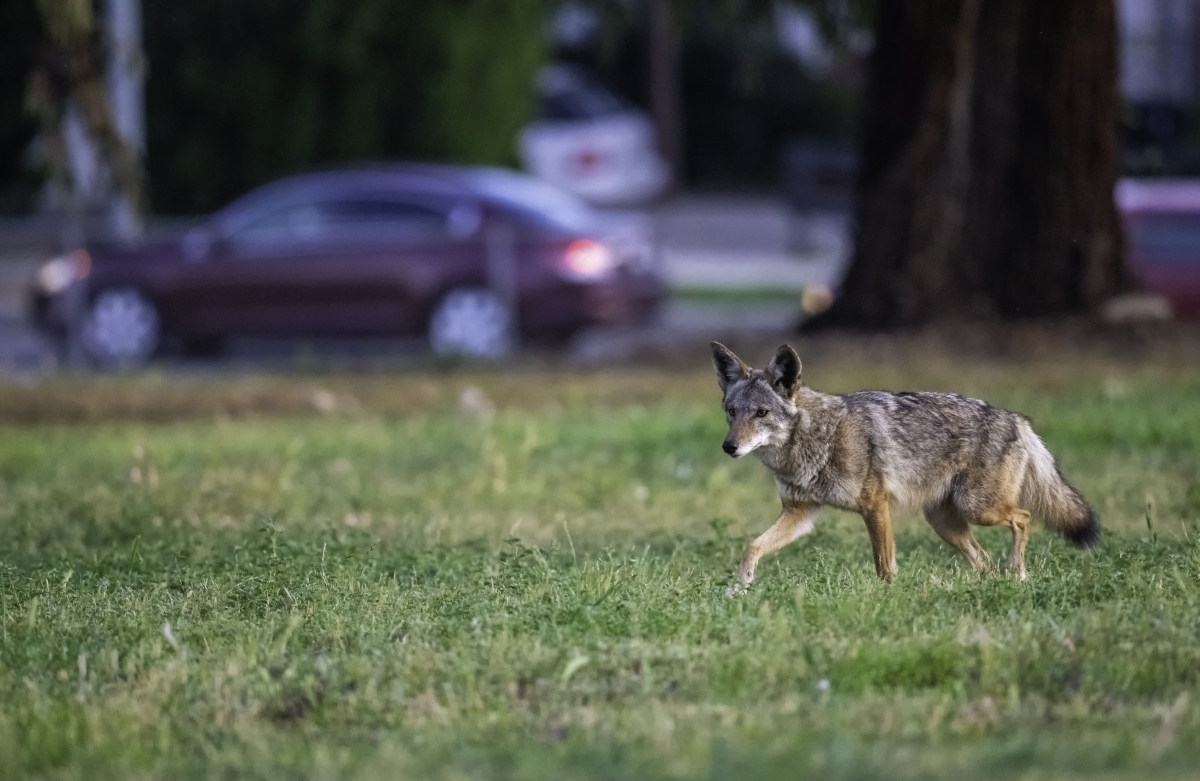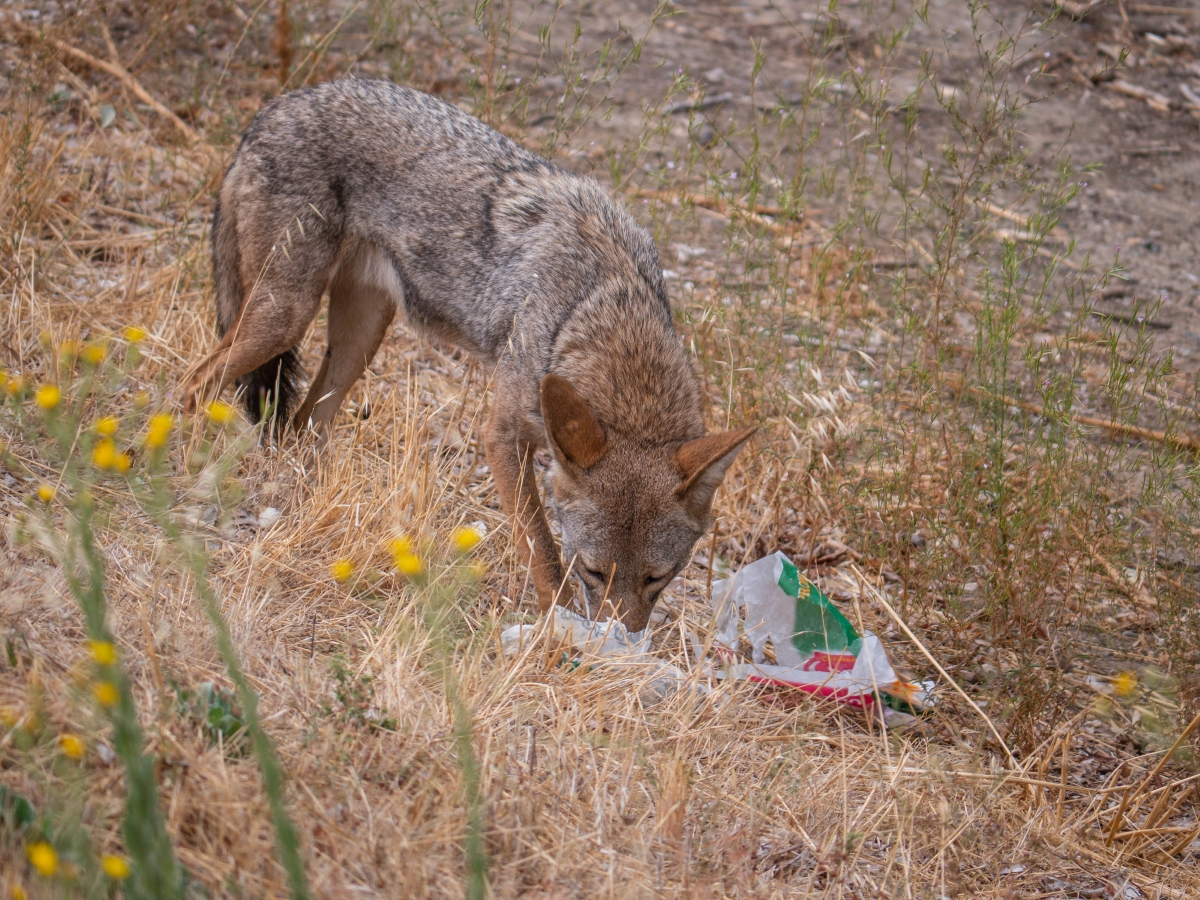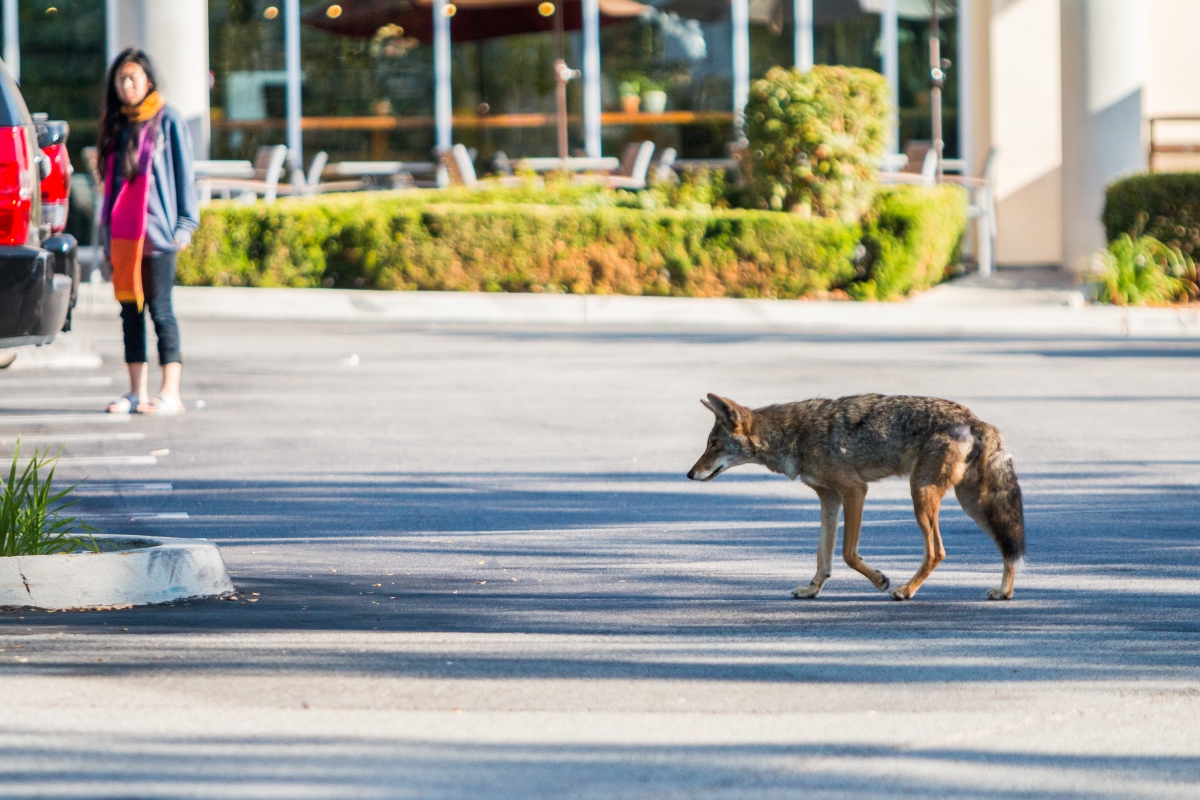

We may earn revenue from the products available on this page and participate in affiliate programs. Learn More ›
Coyotes are common throughout North America. Like other wildlife, they tend to adapt to their environments and might become bolder in urban or suburban neighborhoods. Still, people can easily coexist with coyotes if they follow experts’ tips on coyote behavior, protecting pets, and avoiding feeding coyotes or other wildlife.
One reason coyotes are common is “declining gray wolf populations in the lower 48,” says Sean Neiswenter, Ph.D., associate professor for the University of Nevada, Las Vegas School of Life Sciences. And while you might first be taken aback when you see a coyote strolling down the sidewalk, the animal is not likely to bother you, your pet, or your property. “The best thing you can do, for them and you, is leave them alone and observe them from afar,” says Neiswenter. Read on to learn how to coexist with coyotes, how to get rid of coyotes in the yard, and how to scare away coyotes if you have a close encounter.
Coyotes in Your Neighborhood

Although coyotes might roam around your neighborhood, you might never have to interact with them. According to Project Coyote, most urban interactions involve the presence of a dog near a den or the availability of food nearby. “Urban coyotes and rural coyotes exhibit very different behaviors,” says Dr. Virginia Thompson, urban biologist with the City of Albuquerque Urban Biology Division, Environmental Health Department. Thompson says that urban coyotes have acclimated to living around populations. “They are born and raised in the city and are used to the hustle and bustle, noises, cars, and people,” says Thompson.
If you are unsure whether coyotes live nearby, listen for sounds of howling similar to a dog. Like their canine cousins, coyotes will also bark. Coyote poop often contains hair and bones. Tracks might look like a domestic dog’s, but a coyote’s trail will usually be straight, whereas a domestic dog’s will be winding. The surest sign is to spot a coyote or learn of a neighborhood encounter.
“The best thing you can do, for them and you, is leave [coyotes] alone and observe them from afar.”
—Sean Neiswenter, Ph.D., associate professor University of Nevada, Las Vegas
When Are You Most Likely to See a Coyote?
Coyotes are naturally curious and hungry or thirsty, so they move about throughout the day and night. Their movement can vary based on seasonality; they are protective during pupping season (about April to July) and likely need to search for scarce food more frequently in late winter (November through February). In urban areas, most spottings occur at dawn and dusk, which might be partly urban coyote behavior, but also because that’s when people are most likely out walking.
“I’ve been monitoring coyotes, kit fox, and domestic dogs for several years outside of Las Vegas and have documented coyotes active at all times of the day and year,” says Neiswenter. He’s even spotted them in extreme conditions. Although coyotes might be active, you’re not likely to have an interaction or conflict, with a few exceptions. “While we do find that conflicts can occur with pets—especially when owners have dogs off leash outside of their property—conflicts with humans are almost always driven by human behaviors,” says Thompson.
What Attracts Coyotes to Your Property?

Tops on human behaviors that cause conflicts is trying to feed coyotes. “You should never feed or offer water to any wild animal,” says Neiswenter. “Wild animals that associate humans with food can become problematic, and even worse may become aggressive,” he adds.
“Food, water, and shelter are the most common attractants,” says Thompson. In cities, coyotes primarily eat rats, gophers, insects, and fruit, but also can be attracted to human and pet food or water. She says that even bird feeders, fountains, or ponds can attract small animals, which then attract coyotes. Other attractants include:
- Food left out for feral cats
- Unsecured trash
- Unsealed compost piles or bins
- Dirty barbecue grills
- Fallen fruit from trees left on the ground
- Unsecured chickens, ducks, or rabbits
- Unattended small dogs or cats left outside
- Tall and unmaintained vegetation, especially near structures
Tips for Keeping Coyotes Away
Knowing how to get rid of coyotes on your property starts with removing attractants like food and shelter. They also can become habituated to you and your property if you do not discourage the behavior or give them temptations that make them try to clear a fence or approach your home. Try these tips for keeping coyotes out of your yard:
- Install a tall fence. “Coyotes can easily vault a 6- to 7-foot fence,” says Thompson. She recommends fences be 8 to 10 feet high, depending on the materials and construction. For example, concrete footers keep them from digging under a fence.
- Try making shorter fencing more challenging with fence extensions, coyote rollers, or electric fencing if necessary.
- Install solar LED lights outdoors with motion sensors or ultrasonic deterrents.
- Install motion-activated sprinklers.
- Feed pets indoors, and make sure pet food is never left outside.
- Scent-based coyote repellents are not 100 percent effective, and they need frequent reapplication, but many swear by them.Try one that smells like ammonia, such as predator urine. Human urine works, too.
- Neiswenter says coyotes might make dens under abandoned buildings, so try to prevent access to the crawl spaces or gaps below sheds or other structures around your property to deter dens or other wildlife.
- If a coyote enters your property, use hazing methods to chase it away.
How to Scare Coyotes Away by Hazing
Typically, coyotes are more afraid of you than you are of them. Never run from a coyote, but back away slowly and let it know your “predator” presence with hazing. Hazing methods can help keep coyotes fearful of humans and encourage them to stay away. Yell and wave your arms while approaching a coyote that won’t leave your yard or path. The bigger and bolder your hazing actions, the better. Hazing tools and methods also include:
- “Make eye contact and stand your ground,” says Thompson. You want the coyote to focus on you as a source of fear and discomfort. Just keep enough distance to maintain your safety.
- Use noisemakers like whistles, air horns, or banging metal pans together.
- Shoot water from a garden hose or use a water gun filled with vinegar water to shoot toward the animal.
- Pull your coat over your head, jump up and down, or use pop-up umbrellas while yelling for the coyote to go away.
- Throw pine cones or small rocks near the animal if necessary.
- Hazing does not work well from indoors or in a vehicle; the coyote won’t associate the human inside with the source of fear.
- If the coyote has not been hazed before, it might not run away immediately. Continue to walk toward the animal and increase the volume and intensity of your hazing.
If a coyote returns to your property, you might have to haze several times for it to get the message. Try mixing up your hazing tools or household members who haze. If a coyote frequently returns to the neighborhood, share information about attractants and deterrents with neighbors.
How to Protect Pets and Small Children From Coyotes

Removing attractants like outdoor food and using coyote deterrents like tall fencing can help protect pets in your yard. The best way to keep coyotes from harming small pets or children is to keep them confined within your fences or home when unsupervised. When walking, Thompson says you can mitigate problems with “basic safety measures like keeping pets on a tight 6-foot leash outside your property.” Pick up a small dog or child if a coyote approaches.
Avoid flexible or retractable leashes and stay away from bushy areas or the edges of neighborhoods that border more rural terrain. During pupping season in particular, you could inadvertently walk near a coyote den, which could cause a conflict between the dog and the coyote as the animal defends its family. Of course, never let a dog chase or play with a coyote, or let a child approach or attempt to pet one.
When to Call a Pro for Coyote Removal
If a coyote is resistant or you find undertaking the steps to keep coyotes away is more work than you’re ready for, it might be time to call in a professional. Look for local experts in coyote or wildlife removal, who have years of experience to lean on and expertise in how to keep coyotes away. According to Thompson, “local laws, policies, and services provided regarding wildlife vary by jurisdiction and usually by species as well.” Always contact local authorities if you see an injured coyote or other animal.
If you are bitten or scratched, seek medical attention and contact local urban wildlife authorities and your local health department. Thompson adds that if you encounter an aggressive coyote or suspect it might be injured or sick, contact your local authorities as a matter of safety. This is also true if you find a coyote in a trap or trapped in an area like a backyard.
Neiswenter adds, “It’s easy to look at animals (especially in the desert) and have sympathy for them, similar to what you might feel for a stray dog or cat.” But remember that they are wild animals and though they might face tough conditions, “they were doing fine well before we showed up,” he says, so let them be or contact authorities as recommended above.
FAQs
For the most part, coyotes stay to themselves, and conflicts with humans are rare. Entering an area in which a coyote has a pup den is the most likely reason a coyote will act aggressively or follow you. Feeding the animals is another reason, since it makes them lose some of their natural fear of people.
Aggressive coyotes might show their teeth as they approach or have raised fur on their backs. They could even make a lunging or nipping action toward you or your dog without actual contact. If the animal merely freezes or moves a short distance and stops to watch, it is not likely to be aggressive, says Thompson. Continue your hazing until it leaves the area.
If you encounter an aggressive coyote, back away slowly and haze the animal noisily. Make your presence large and loud to stoke fear in the coyote. If the animal is “escorting” you by following you or your dog as you walk, the coyote is likely making sure you leave the area of the den. Always be safe by backing up or approaching at safe distances, and keeping eye contact with the coyote while calmly leaving the area.
There is no need to haze a coyote who maintains a comfortable distance, so do not be alarmed by their presence. Actual human-coyote interactions are rare, and the animals play a role in maintaining a balanced ecosystem, even in urban areas. One coyote can eat up to 1,000 rodents a year. They also prefer to eat voles and rabbits, which can be garden pests. Neiswenter said other than occasional digging around a fence, he is unaware of property damage from coyotes.
Local or state urban wildlife offices are excellent sources for more information on coyotes, as is Project Coyote. The organization also has resources for developing coyote-friendly communities. Neiswenter says to learn more about wildlife sightings and patterns of activity, anyone can visit Snapshot USA.
